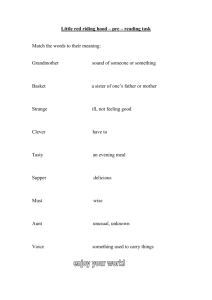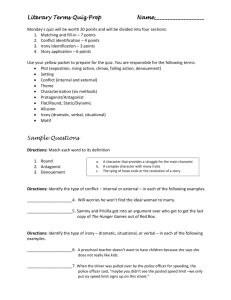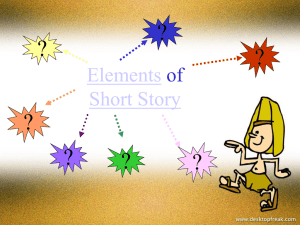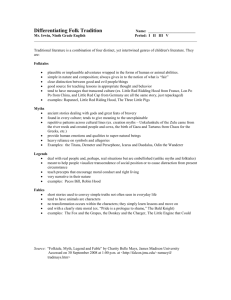ENG1D1 Myth Function
advertisement
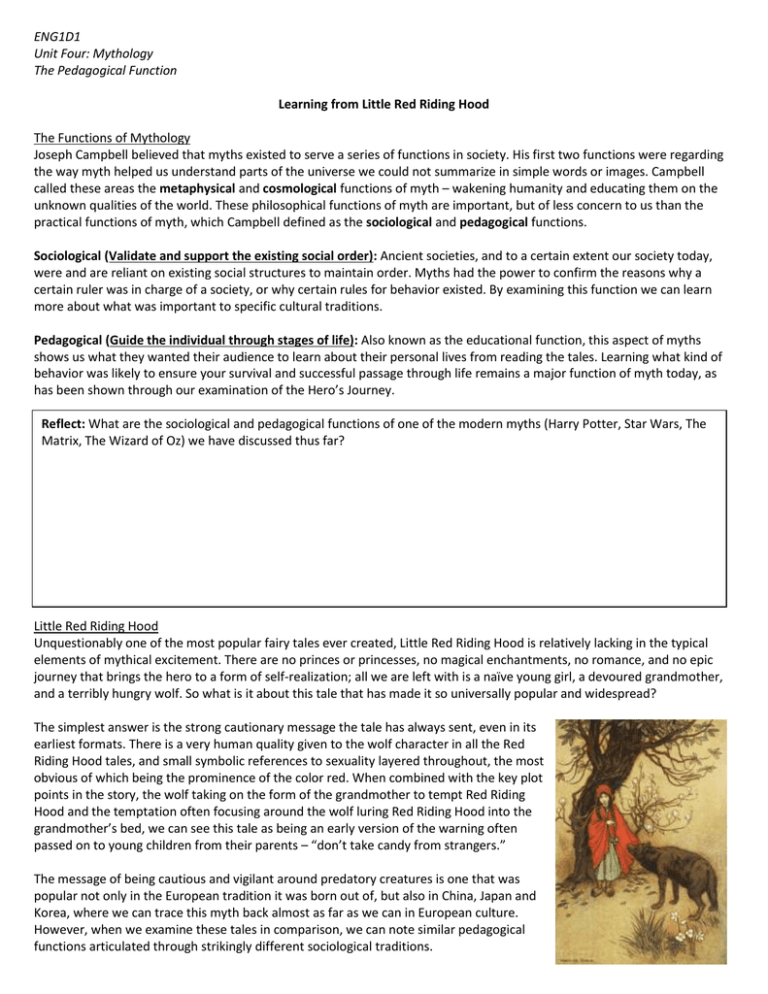
ENG1D1 Unit Four: Mythology The Pedagogical Function Learning from Little Red Riding Hood The Functions of Mythology Joseph Campbell believed that myths existed to serve a series of functions in society. His first two functions were regarding the way myth helped us understand parts of the universe we could not summarize in simple words or images. Campbell called these areas the metaphysical and cosmological functions of myth – wakening humanity and educating them on the unknown qualities of the world. These philosophical functions of myth are important, but of less concern to us than the practical functions of myth, which Campbell defined as the sociological and pedagogical functions. Sociological (Validate and support the existing social order): Ancient societies, and to a certain extent our society today, were and are reliant on existing social structures to maintain order. Myths had the power to confirm the reasons why a certain ruler was in charge of a society, or why certain rules for behavior existed. By examining this function we can learn more about what was important to specific cultural traditions. Pedagogical (Guide the individual through stages of life): Also known as the educational function, this aspect of myths shows us what they wanted their audience to learn about their personal lives from reading the tales. Learning what kind of behavior was likely to ensure your survival and successful passage through life remains a major function of myth today, as has been shown through our examination of the Hero’s Journey. Reflect: What are the sociological and pedagogical functions of one of the modern myths (Harry Potter, Star Wars, The Matrix, The Wizard of Oz) we have discussed thus far? Little Red Riding Hood Unquestionably one of the most popular fairy tales ever created, Little Red Riding Hood is relatively lacking in the typical elements of mythical excitement. There are no princes or princesses, no magical enchantments, no romance, and no epic journey that brings the hero to a form of self-realization; all we are left with is a naïve young girl, a devoured grandmother, and a terribly hungry wolf. So what is it about this tale that has made it so universally popular and widespread? The simplest answer is the strong cautionary message the tale has always sent, even in its earliest formats. There is a very human quality given to the wolf character in all the Red Riding Hood tales, and small symbolic references to sexuality layered throughout, the most obvious of which being the prominence of the color red. When combined with the key plot points in the story, the wolf taking on the form of the grandmother to tempt Red Riding Hood and the temptation often focusing around the wolf luring Red Riding Hood into the grandmother’s bed, we can see this tale as being an early version of the warning often passed on to young children from their parents – “don’t take candy from strangers.” The message of being cautious and vigilant around predatory creatures is one that was popular not only in the European tradition it was born out of, but also in China, Japan and Korea, where we can trace this myth back almost as far as we can in European culture. However, when we examine these tales in comparison, we can note similar pedagogical functions articulated through strikingly different sociological traditions. ENG1D1 Unit Four: Mythology The Pedagogical Function Little Red Riding Hood by Charles Perrault 1) Describe the characters of Little Red Riding Hood and the Wolf. Who seems to have control in this story? Are either of them representative of one of the major character archetypes? _____________________________________________________________________________________________________ _____________________________________________________________________________________________________ _____________________________________________________________________________________________________ 2) What happens to Little Red Riding Hood at the end of the story? How could this have been prevented? _____________________________________________________________________________________________________ _____________________________________________________________________________________________________ 3) What does this conclusion and the moral at the end of the story tell us about the sociological and pedagogical functions of this myth? _____________________________________________________________________________________________________ _____________________________________________________________________________________________________ _____________________________________________________________________________________________________ The Chinese Red Riding Hoods by Isabelle C. Chang 1) Describe the three Red Riding Hood’s and the Wolf in this version of the story. How are they similar and different from the characters we saw in the first tale? _____________________________________________________________________________________________________ _____________________________________________________________________________________________________ _____________________________________________________________________________________________________ 2) What happens to the Wolf at the end of the story? How was this achieved? _____________________________________________________________________________________________________ _____________________________________________________________________________________________________ 3) What does this conclusion tell us about the sociological and pedagogical functions of this myth? _____________________________________________________________________________________________________ _____________________________________________________________________________________________________ _____________________________________________________________________________________________________
